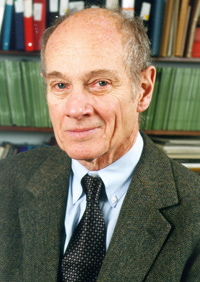|
||
      |
Birthday spark
Friends of physicist James Cronin, SM’53, PhD’55, say it’s fitting that the Nobel laureate shares a September 29 birthday with U of C physics pioneer Enrico Fermi. More than 300 of Cronin’s friends, colleagues, and family filled Max Palevsky Cinema a few weeks early as part of the Enrico Fermi Institute’s Croninfest, a weekend-long pre-celebration of the professor emeritus’s 75th birthday.

Birthday Nobelist James Cronin.
Attendees came from all parts of the country to mark the occasion, which included seminars on Cronin’s groundbreaking contributions and ongoing work in physics.
While at Princeton University in 1964, Cronin and fellow physicist Val Fitch proved that a reaction run in reverse does not follow the path of the original reaction, suggesting that time has an effect on subatomic-particle interactions. The experiment uncovered the CP violation, or a break in particle-antiparticle symmetry, and earned Cronin and Fitch the 1980 Nobel Prize in Physics.
“CP violations provide a window into the early history of the universe,” said Lincoln Wolfenstein, SB’43, SM’44, PhD’49, a former Carnegie Mellon particle physicist whose work has elaborated on Cronin’s discoveries, prior to the event. “There’s a hope we can understand why the universe has more particles than antiparticles,” he added. “Maybe CP violations are why we’re here.”
University of Pittsburgh professor emeritus Eugene Engels, Cronin’s first graduate student as a Princeton University professor from 1958 to 1971, addressed the audience first. “Jim was very interested in seeing what the spark chamber could do,” Engels said, adding that it was Cronin’s achievements that inspired him to pursue spark-chamber research, detecting electrically charged particles. Summarizing Cronin’s seminal 1964 experiment for the audience, Engels hailed the test as “the most perfect spark-chamber event created by the hand of man.” He then reflected on his early grad-student career, calling his working relationship with Cronin “the two most important years in my becoming a physicist.”
Cronin, who retired from Chicago in 1997 and is spokesman emeritus for Argentina’s Pierre Auger Observatory, sat front-row and center, a rare turn on the other end of the lecture podium.